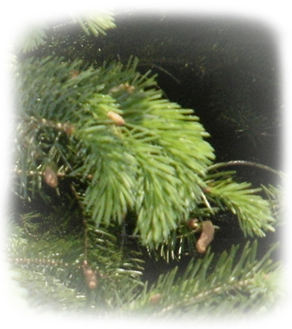Spruce, Epinette • Legend and Lore • In the Garden |
|
Picea spp
Pinaceae
Legend and Lore Stradiavarus used spruce trees to make his renowned violins because of its light weight but tough wood and the resonant properties; today violins, guitars, harps and the sounding boards of pianos are still made with spruce. The Golden Spruce Legend from the Haida in BC begins about 300 years ago; a human who was transformed into an Elder Tree sixteen stories tall and six metres in width is unique in the botanical world as the Sitka Spruce lacks 80% of a normal tree’s chlorophyll. The legend is similar to the Biblical Lot’s Wife that turns into a pillar of salt – a young boy and his grandfather running away from their village buried in snow for the resident’s wicked actions; the boy looked back against his Elder’s warning and turned into the Golden Spruce. The legend also states that the tree would be admired until the last generation. In 1997 the tree was felled as an environmental protest sending a shockwave within the Haida community and the media took notice of logging practices. Spruce is often chosen as a Christmas tree; extract of the shoots and needles can be used to make spruce beer. All parts were used for food, medicine, cooking and building material by Canada’s Aboriginal People. High in Vitamin C; great preventative of scurvy and gives the immune system a great boost. Picea is from the Latin meaning pix = pitch or resin which flows when the tree is damaged. In the Garden Sun to light shade, specimen trees or as windbreaks, screens; excellent evergreens providing a huge range of sizes and shapes. Slow growing taking decades to mature in Southern Canada and centuries up North. Tolerates a variety of soils, but not poor or sandy, preferring moist sites but not saturated. Found on all continents but Antarctica; there is a lone spruce on Campbell Island a Sub-Antarctic Island of New Zealand! Needles (leaves) are ½” to 1 1/4” long, twigs either dense with short hairs or hairless; scales on terminal buds. Very little pruning is necessary, dense compact growth with strong outlines results in versatile application in the landscape. |
|


